Disclaimer: This post may contain Amazon affiliate links. Sudachi earns a small percentage from qualifying purchases at no extra cost to you. See disclaimer for more info.
Featured Comment:
“This was absolutely delicious!! I forgot to snag a picture since we devoured it so fast. Thank you for recreating the recipe from the show!!”
– Shannon (from Pinterest)
What is Chaliapin Steak?
Chaliapin steak (シャリアピンステーキ) is a super soft steak that has been marinated in grated or finely chopped onions to make it extremely tender and then served topped with onions and a rich red wine sauce.
I have to be honest; I’d never heard of this dish until the anime “Shokugeki no Soma” (食戟のソーマ) made it popular, but it’s a real Japanese steak dish with an interesting history!
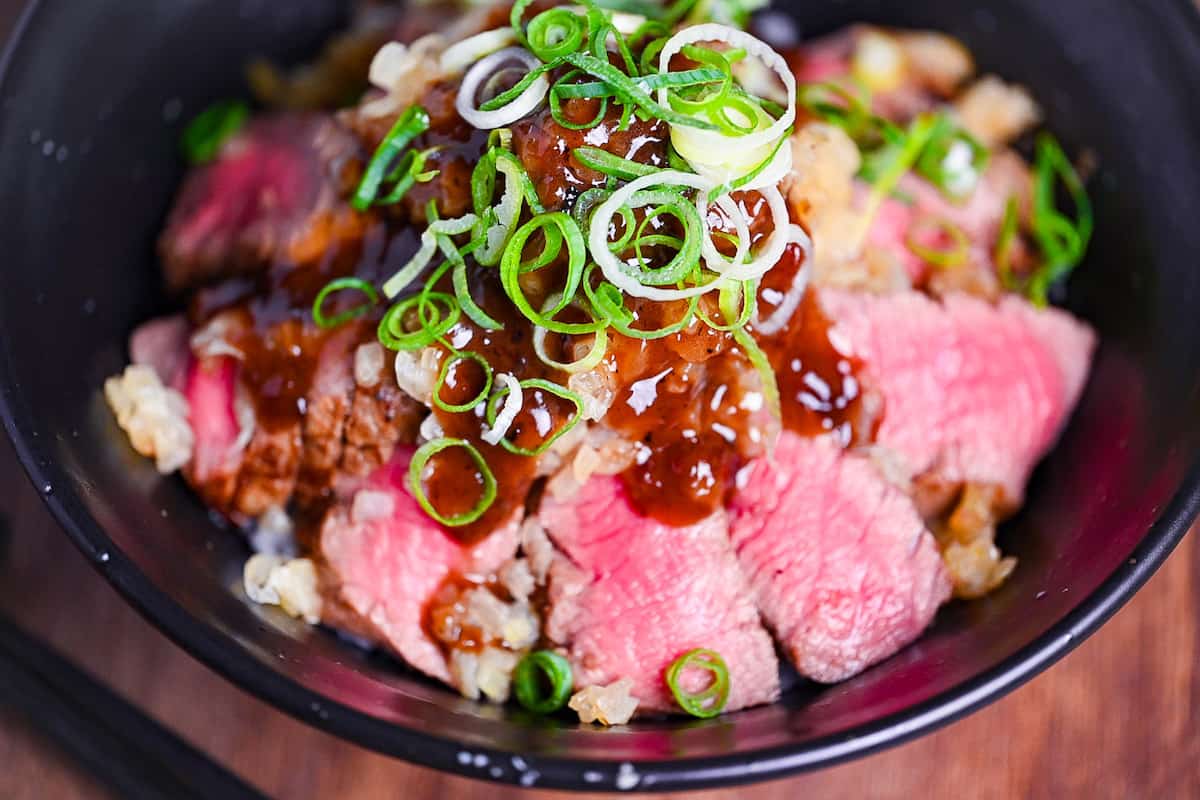
Chaliapin steak was created by a chef working at the Imperial Hotel in Tokyo in 1936.
During that time, a Russian opera singer named Feodor Chaliapin was visiting Japan. He was said to be suffering from toothaches during his visit and requested an extra tender steak to prevent worsening the pain. A chef named Fukuo Tsutsui fulfilled his request, and the Chaliapin steak was born!
Tsutsui’s method for making the steak extremely soft included beating it with a meat tenderizer and then coating it in chopped onions. It is believed that he got the idea from using onions in beef sukiyaki.
Food Wars! Shokugeki no Soma
As I mentioned, Chaliapin Steak gained popularity through a famous anime called “Shokugeki no Soma” (食戟のソーマ) in Japanese and “Food Wars!” in English.
The recipes featured there create a lot of hype online, and even though they’re animated, you have to admit that they look so delicious.
One thing that captured my interest was making Chaliapin steak into a donburi dish and using “umeboshi” pickled plum paste to flavor the rice. I had to try it out! I added my own twist by adding sliced shiso leaf to the rice too; shiso and ume taste great together.
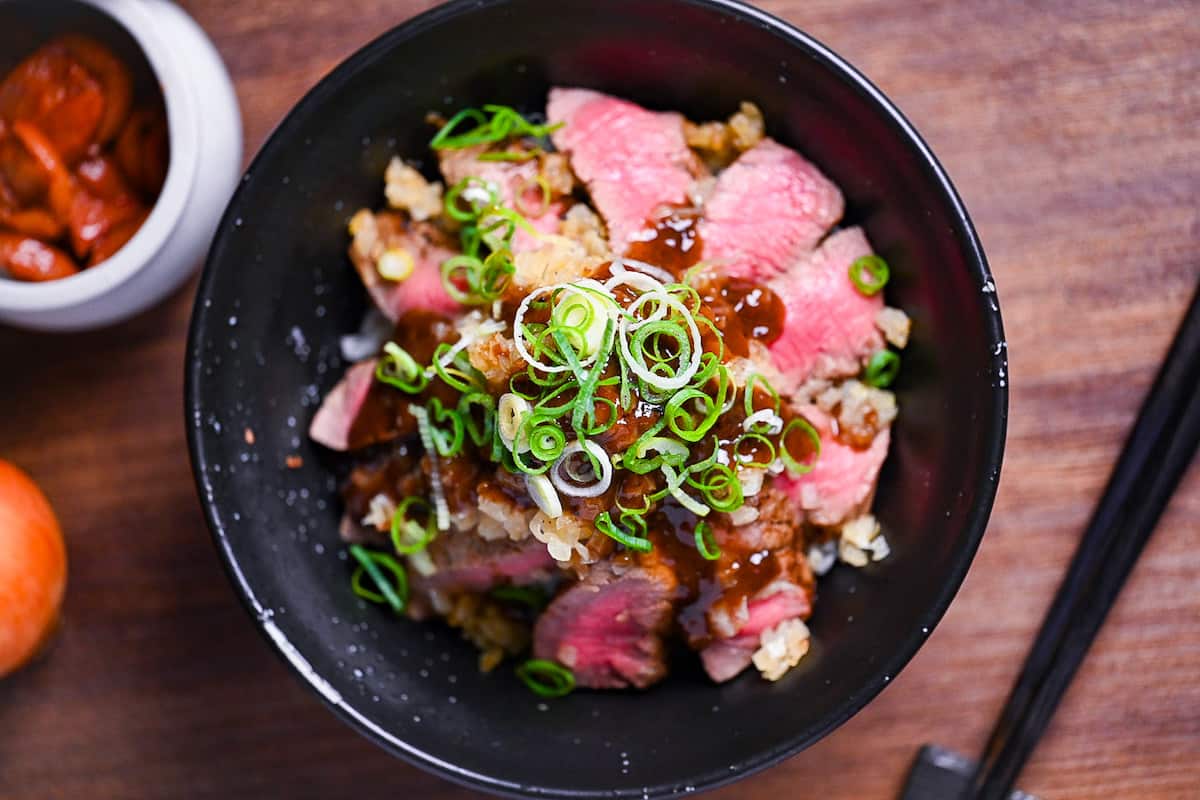
Ingredients & Substitution Ideas
- Thick Sirloin Steaks or Fillet: Opt for cheaper cuts like sirloin, chuck, or chuck eye. Ensure it’s thick for slices with a pink center.
- Yellow Onions: Tenderizes beef in a Shaliapin style and flavors the sauce.
- Unsalted Butter: Use unsalted to control the saltiness; adjust if using salted.
- Beef Fat or Neutral Oil: Choose beef dripping or a high smoke point oil like vegetable or canola.
- Cooked Japanese Short-Grain Rice: Short-grain is best for donburi. Refer to my how to cook Japanese rice guide for cooking tips and recommended brands.
- Pickled Plums (Umeboshi): Adds a unique sour and salty flavor to the rice. It’s popular in Japan and available in Japanese supermarkets or online.
- Perilla Leaves (Optional): Also known as ooba or shiso, adds a fresh, herby touch.
- Finely Chopped Green Onion: For garnish.
- Sauce Ingredients: Unsalted butter, red wine, soy sauce, water, and cornstarch or potato starch.
Curious about the exact brands and products that bring my recipes to life? Discover the brands and ingredients behind my recipes at the Sudachi Amazon Storefront. Explore my handpicked pantry essentials and find your next kitchen favorites!
Jump to Full Recipe MeasurementsVisual Walkthrough & Tips
Here are my step-by-step instructions for how to make Chaliapin Steak Donburi at home. For ingredient quantities and simplified instructions, scroll down for the Printable Recipe Card below.
Firstly, grate or blitz one-third of the onions in a food processor.
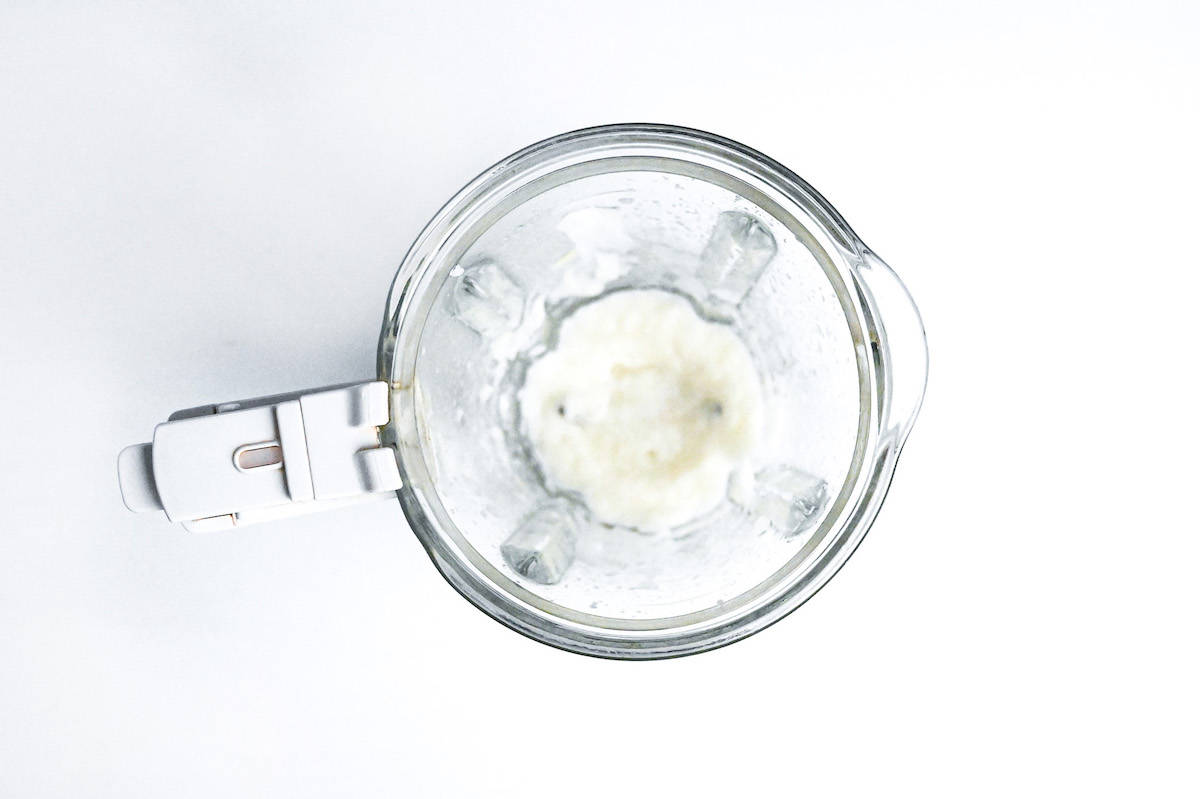
Wrap thick sirloin steaks with cling film and pound them to about 1.5 – 2 cm thick using a meat tenderizer or rolling pin.
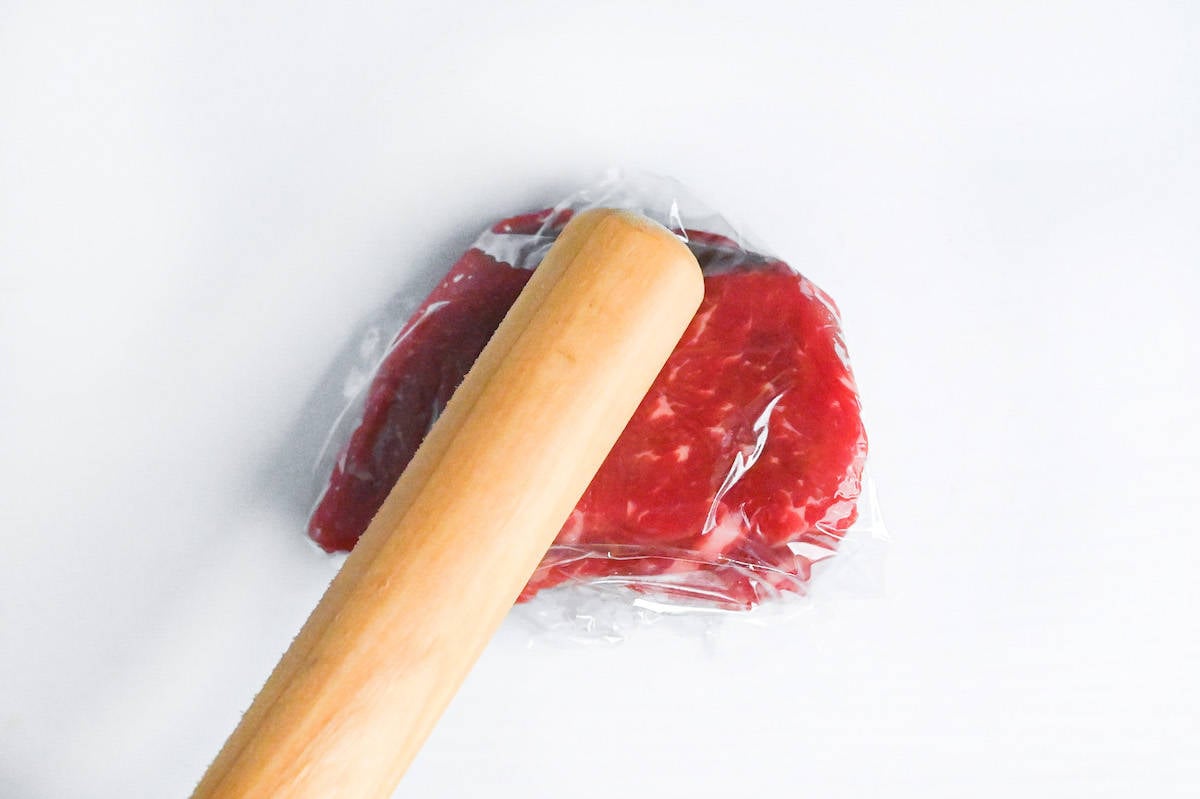
Unwrap and score both sides diagonally with a sharp knife, being careful not to cut too deeply.
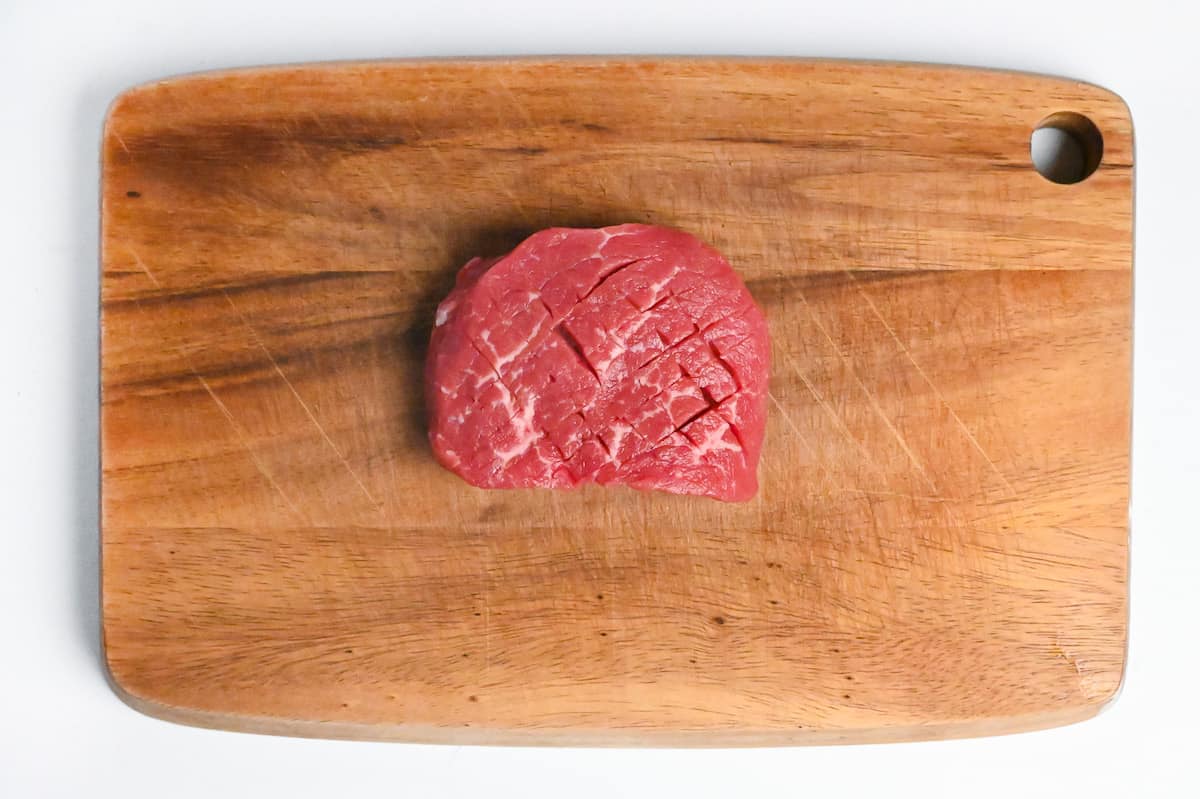
Then, line a plate or container with half of the grated onion, place the steaks on top, and cover with the remaining onion. Cover and let rest for 30 minutes in a cool place (not the refrigerator).
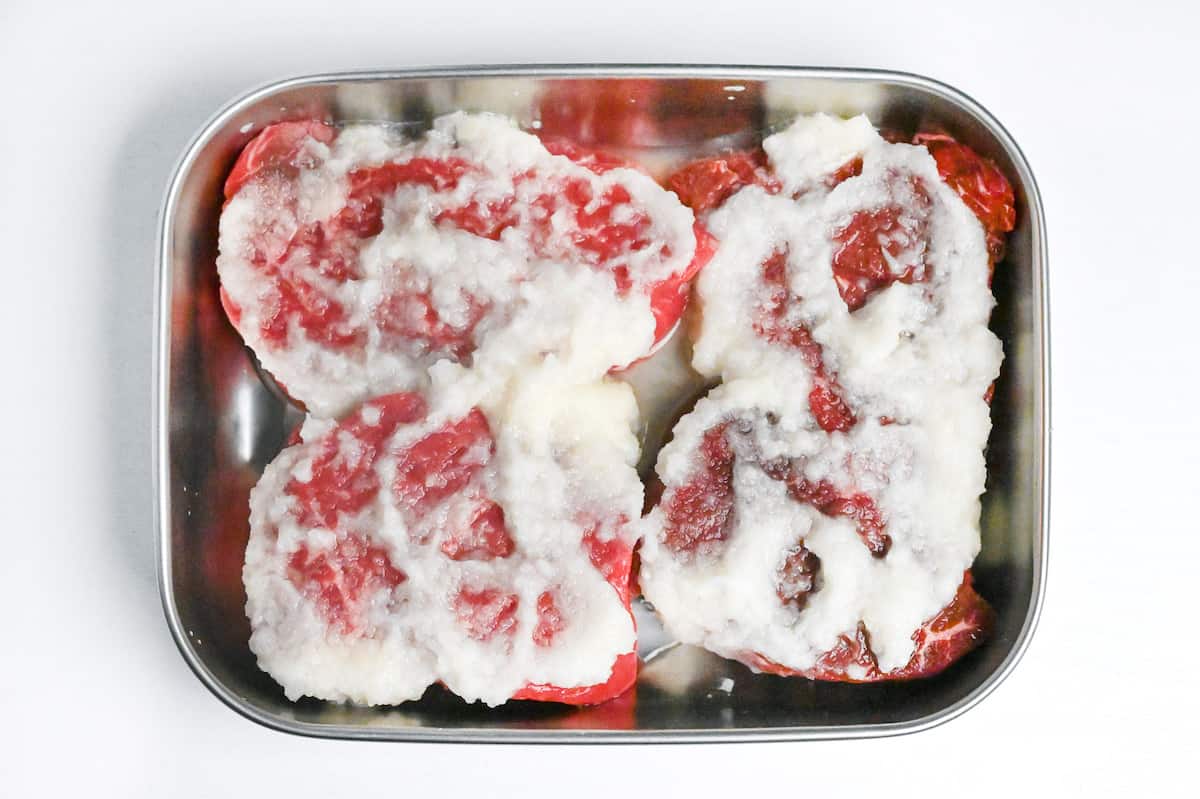
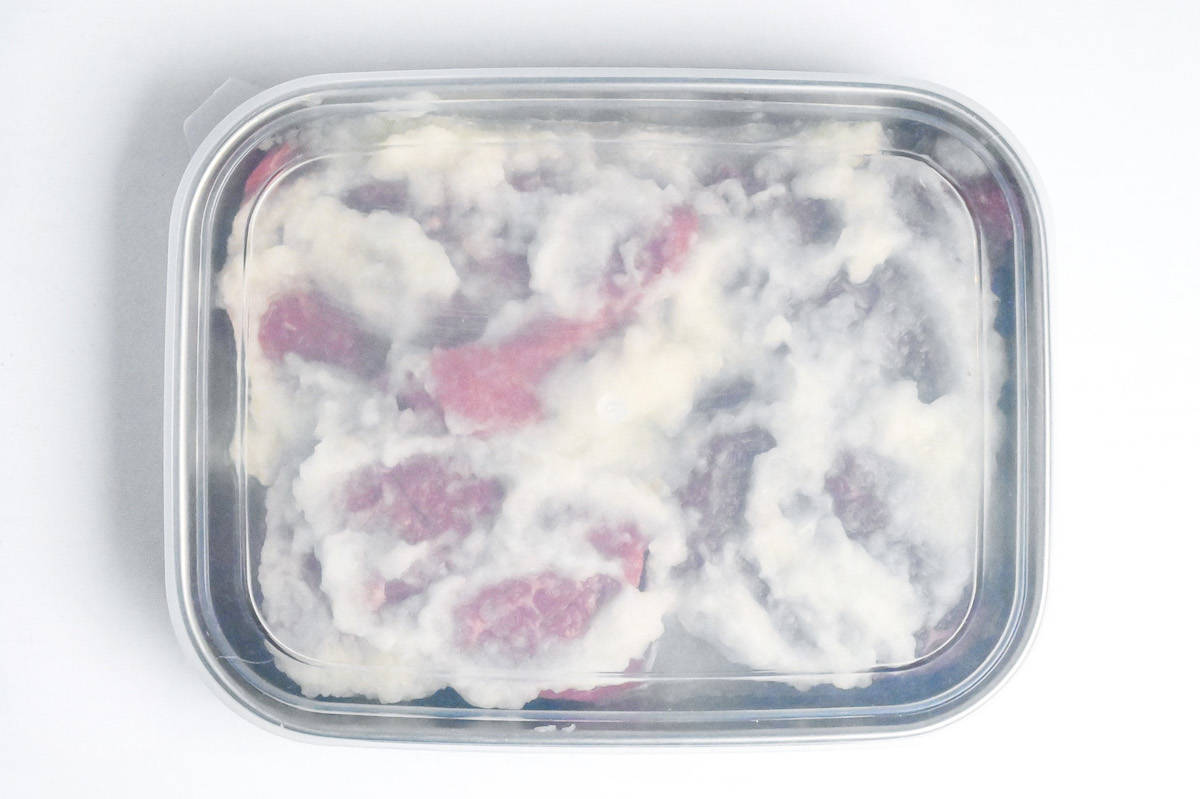
The process of tenderizing meat involves breaking down proteins and muscle fibers to make the meat soft and tender. There are several ways to achieve this, such as marinating the meat, using a meat tenderizing tool, making crosshatch patterns with a knife, poking holes, slicing against the grain, allowing the meat to reach room temperature before cooking, and resting the meat after cooking.
Personally, I find marinating to be the most common method I use in my recipes. Acidic ingredients like lemon, pineapple, vinegar, and even yogurt are great for breaking down the proteins in beef. These ingredients contain “proteolytic enzymes,” which can also be found in onions.
In this particular recipe, we’re aiming for extremely tender meat so that I will be using all of these techniques and a lot of onions.
Finely chop the rest of the onions.
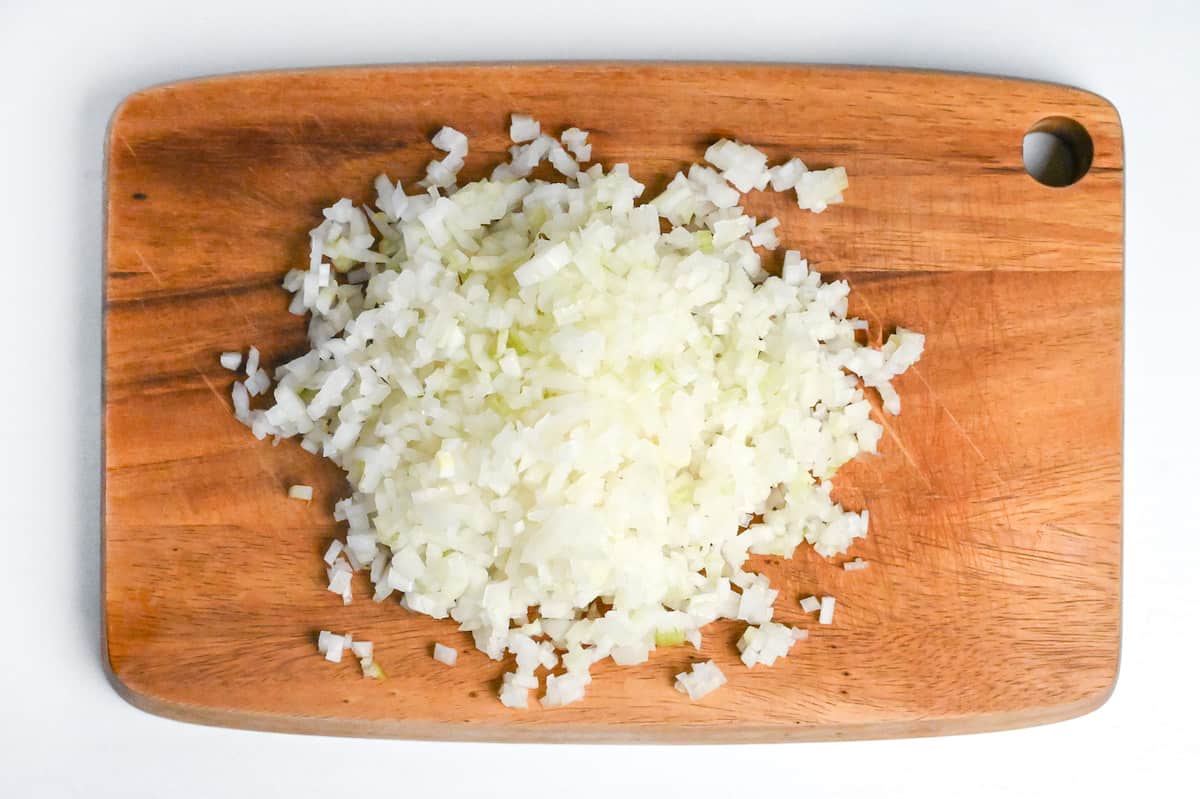
Melt unsalted butter in a frying pan over medium heat, add the onions, and fry until they’re lightly golden and softened.
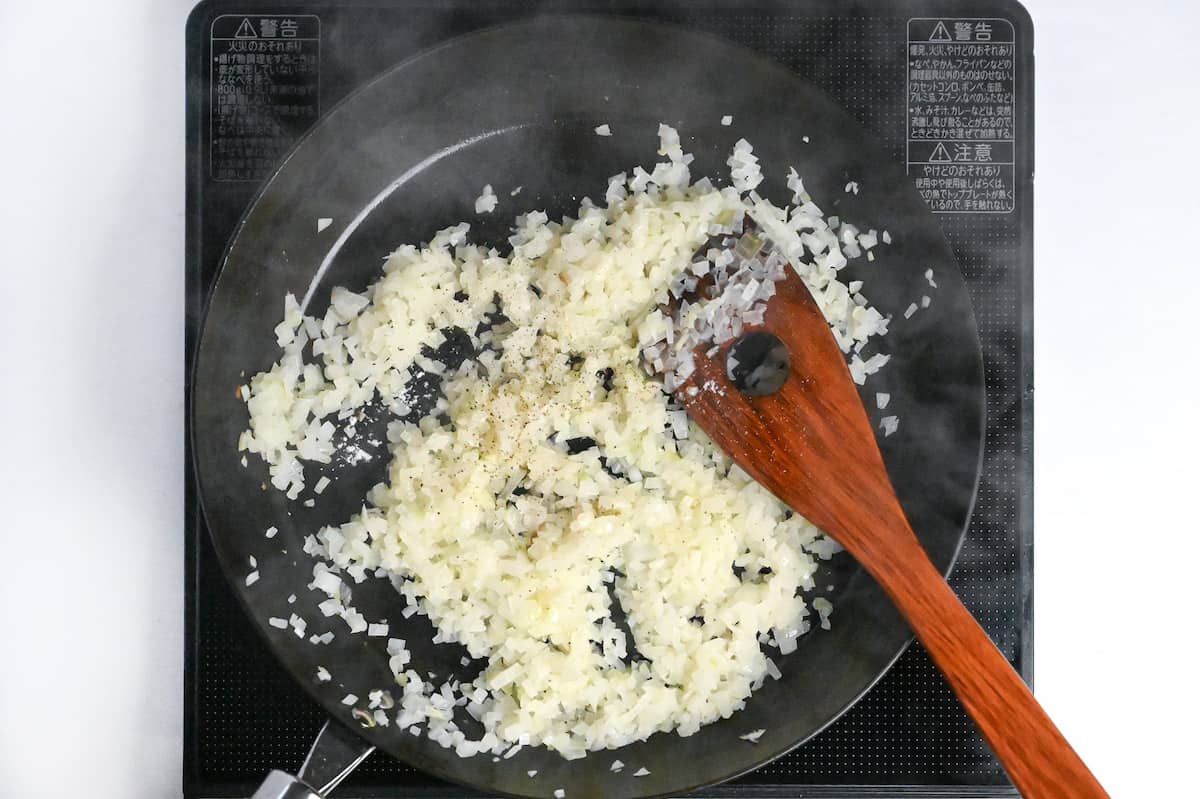
Season with a pinch of salt and pepper, continue frying until golden brown, then set aside.
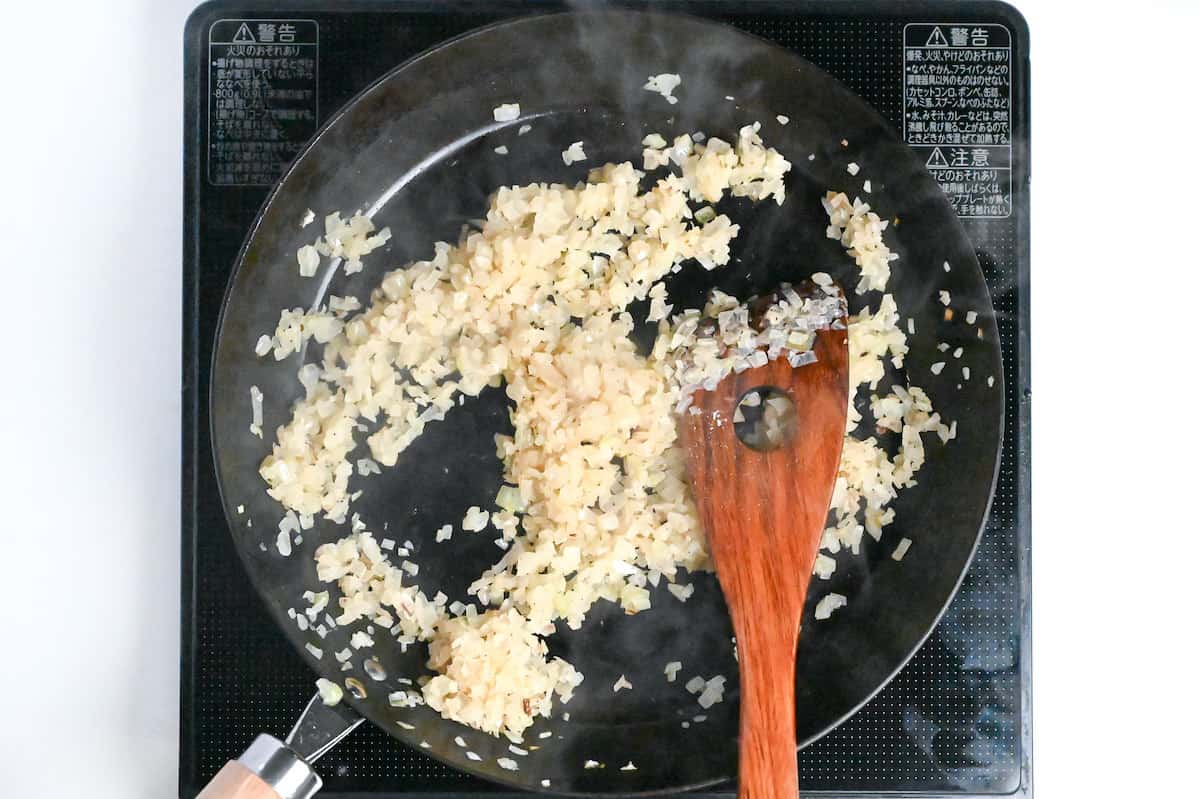
Before cooking, remove the onion from the steaks, wash them with cold water, and pat dry.
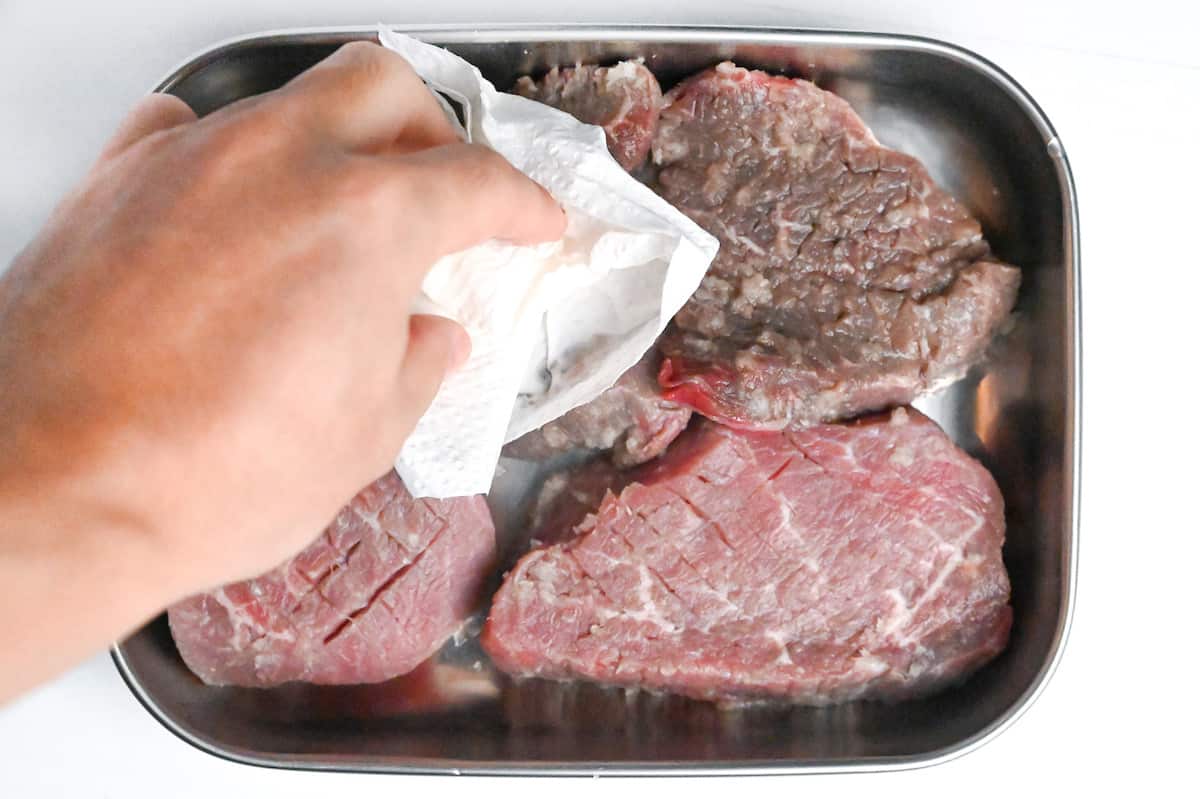
Heat 1 tablespoon of beef fat in a pan over high heat. Season the steaks with salt and pepper and fry to your desired doneness—I suggest rare or medium rare, around 53°C (127°F).
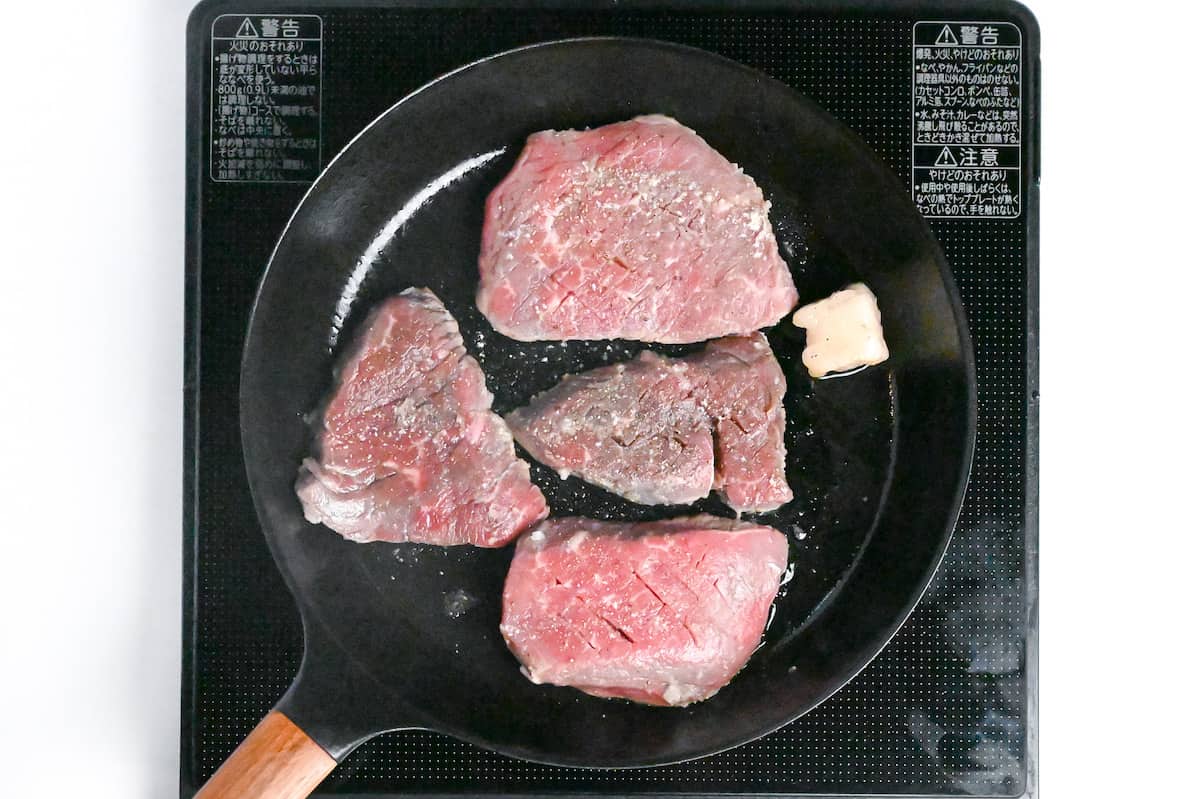
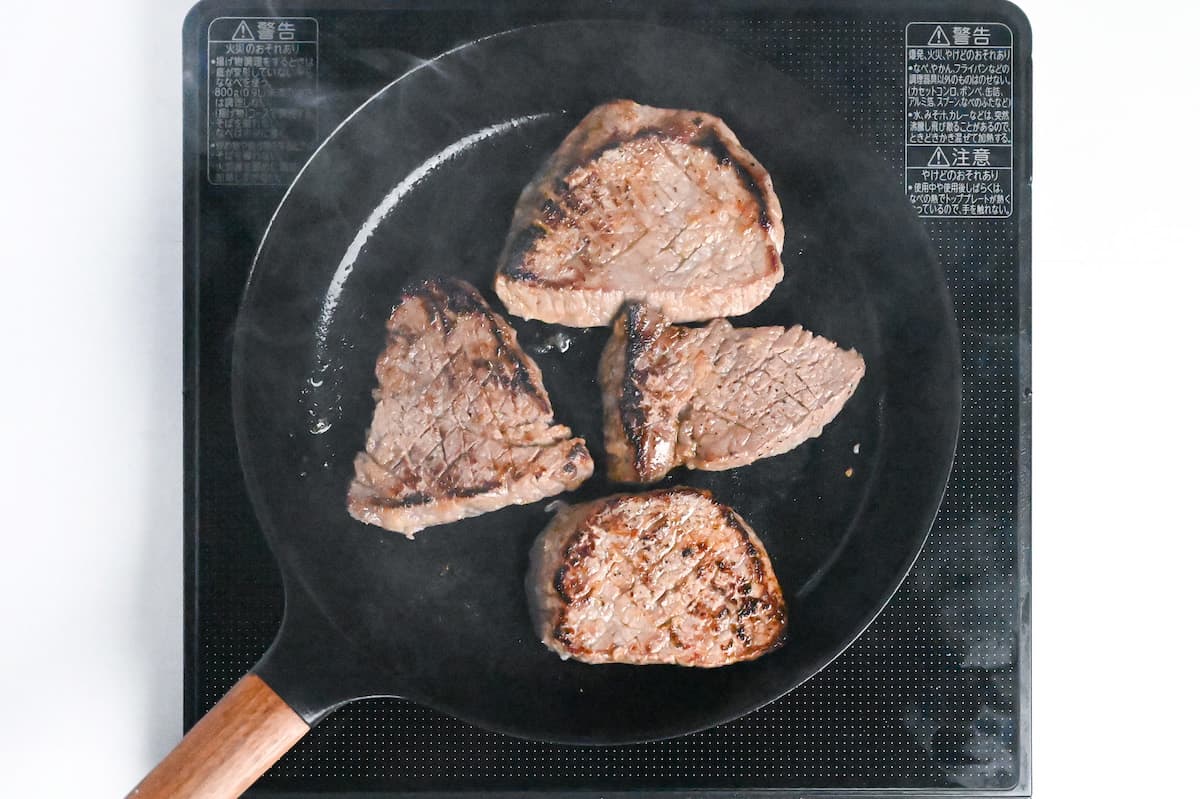
Once done, transfer the steaks to a plate to rest.
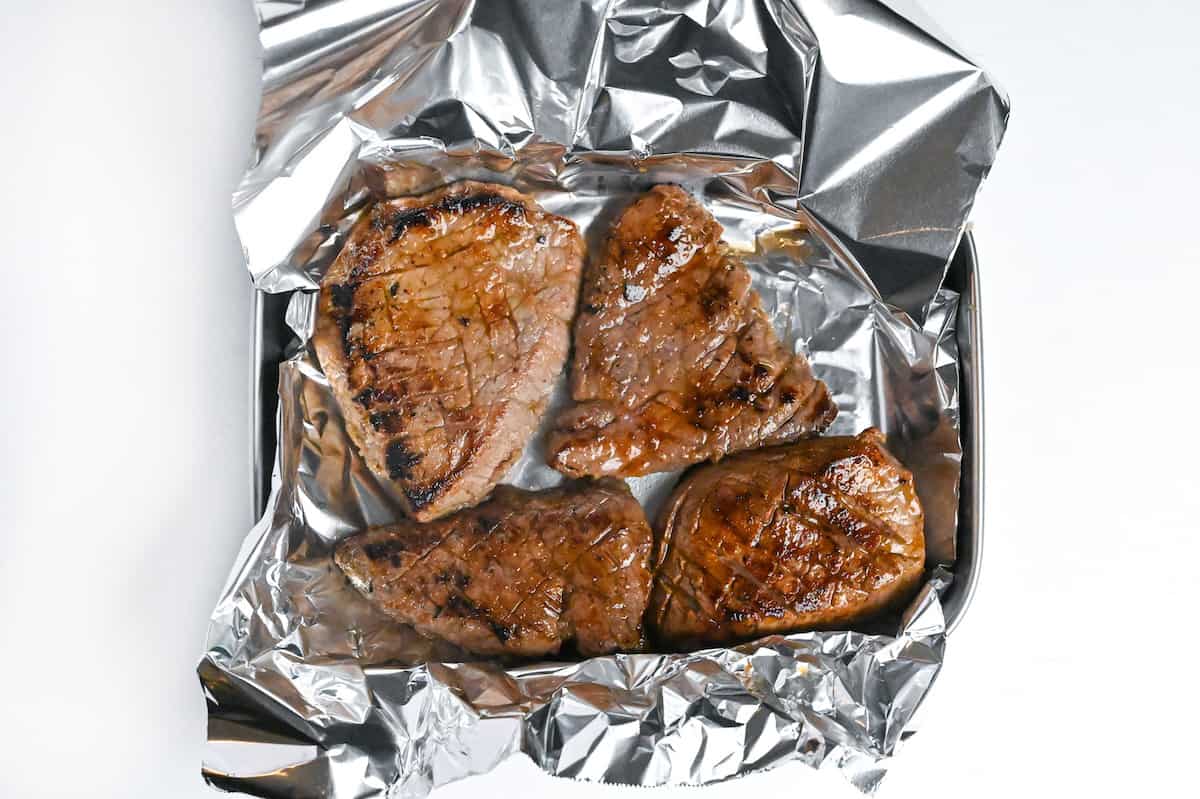
Please remember that serving the steak rare or medium-rare is recommended for the recipe. However, if you prefer a well-done steak, it can still be cooked that way.
It’s challenging to provide an exact time for how long it takes to cook the steak to your preferred level of doneness. Several factors impact cooking time, such as the thickness of the steak, whether the steak is at room temperature or straight out of the fridge (it’s recommended to bring it to room temperature before cooking), and even the type of pan used, and its heating capacity.
With this in mind, rather than giving you time, I want you to follow the chart below!
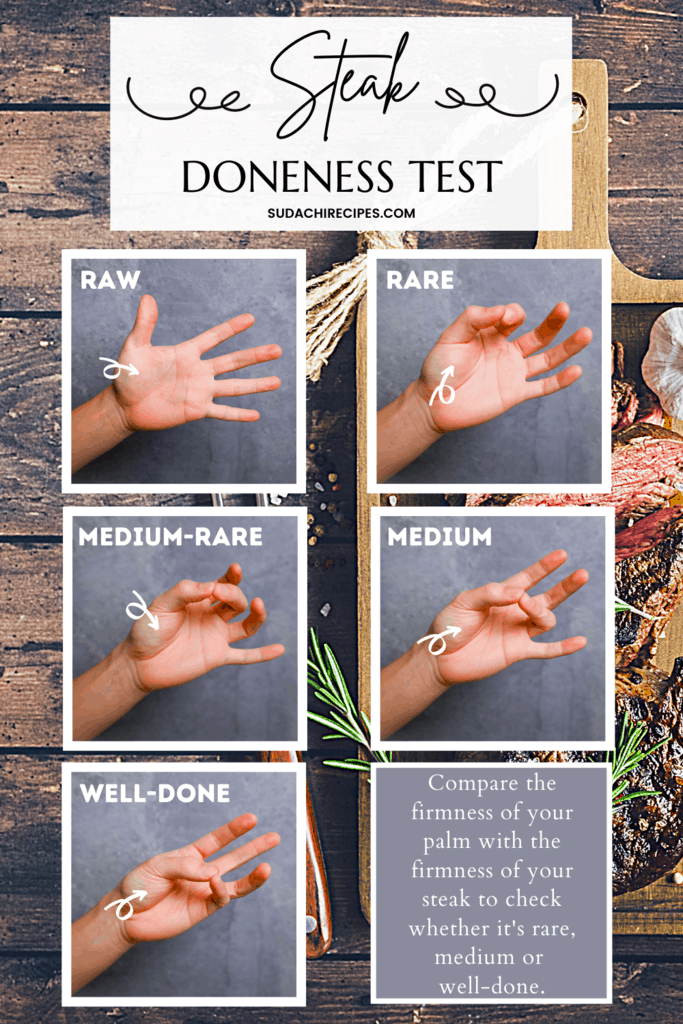
If you use this method of comparing the firmness of your palm with the firmness of your steak, you’re on the road to making the perfect steak every time! It’s easy to remember, too!
In the same pan, melt unsalted butter over medium heat. Add soy sauce, red wine, and the remaining juices from the steaks. Let it simmer for a minute.
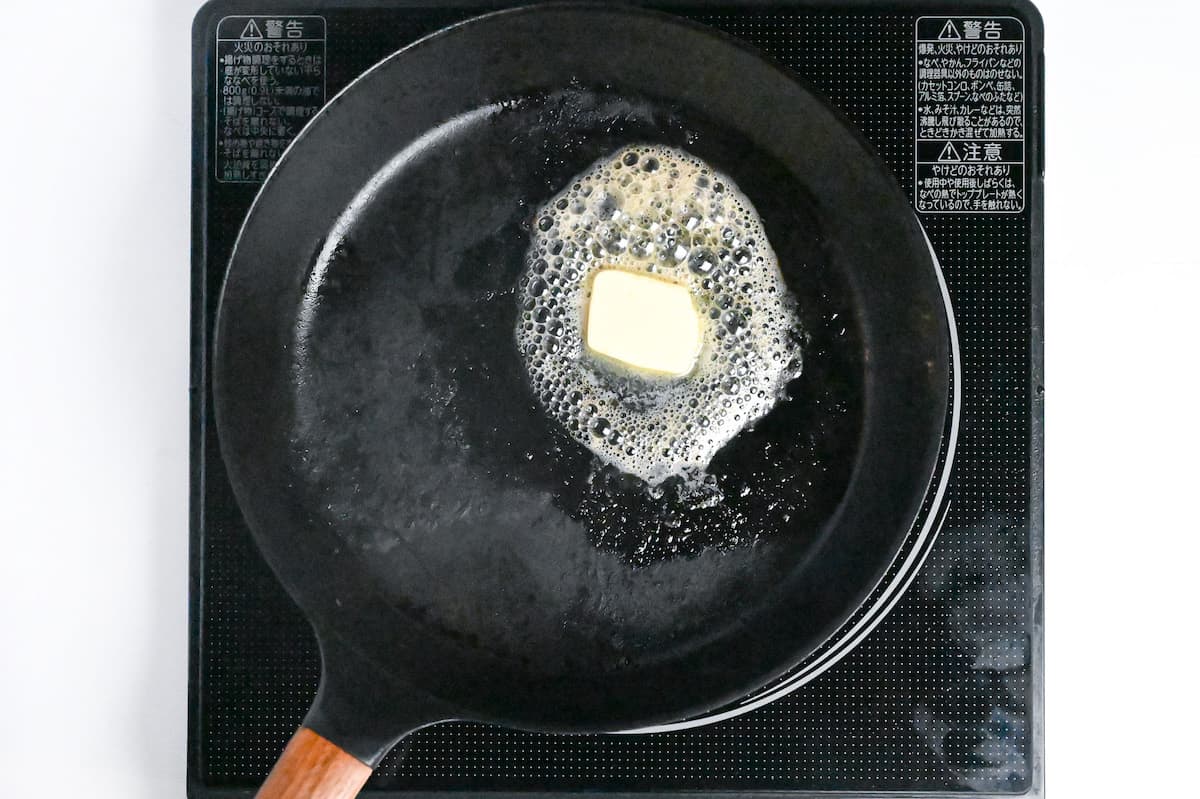
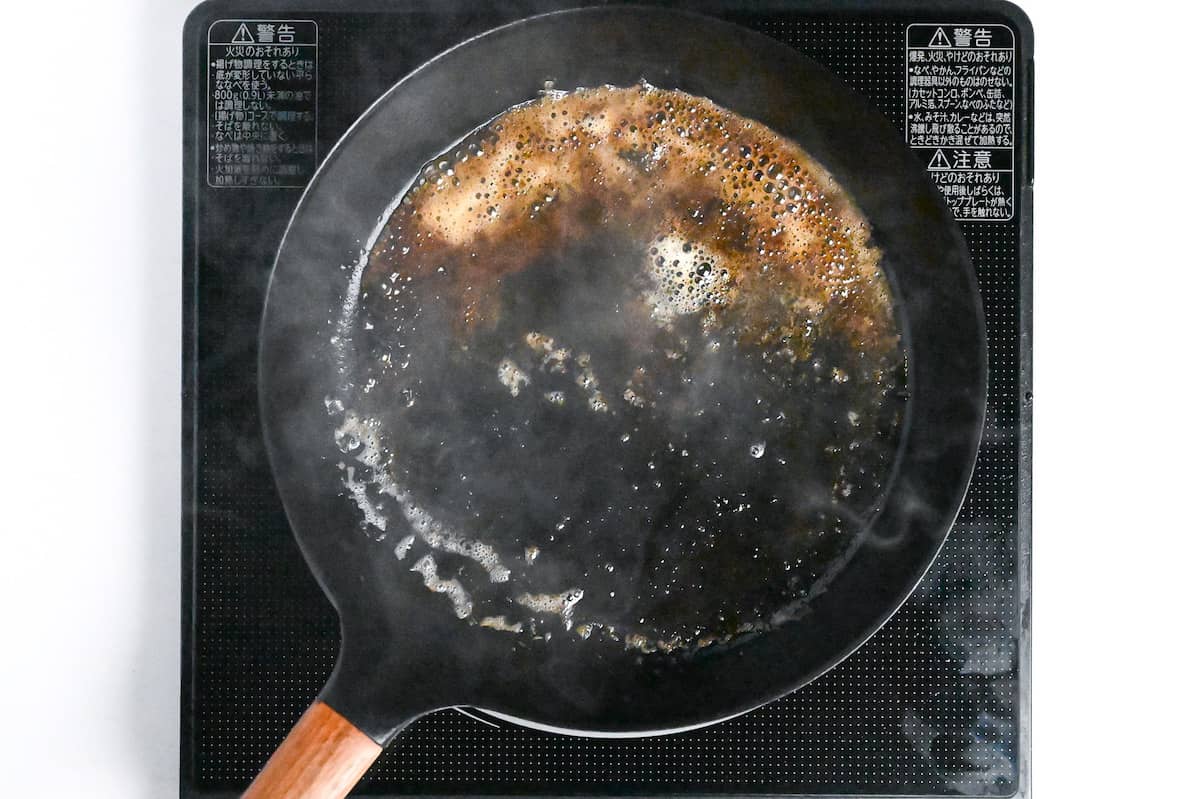
Meanwhile, mix water with cornstarch to make a slurry. Pour this into the pan and cook until the sauce thickens to a gravy-like consistency.
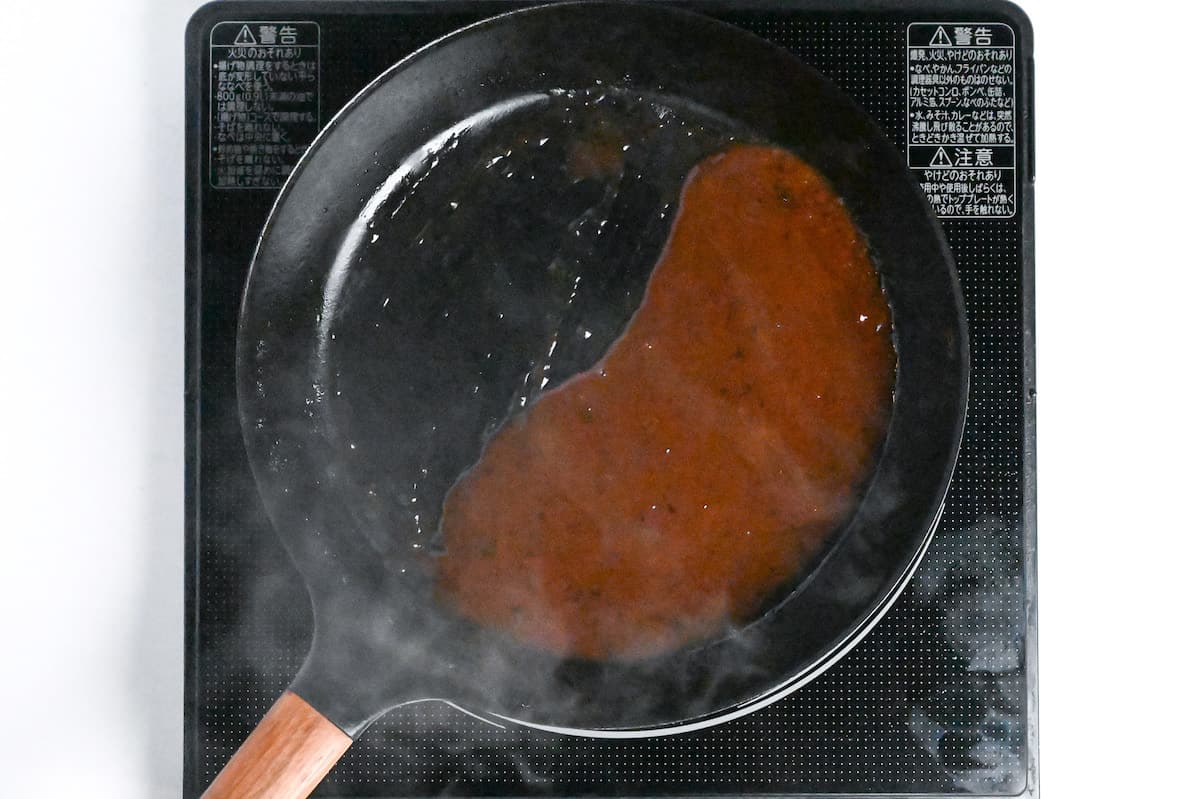
For the ume rice, thinly slice perilla leaves and remove the seeds from pickled plums. Chop the plums finely until they form a paste.
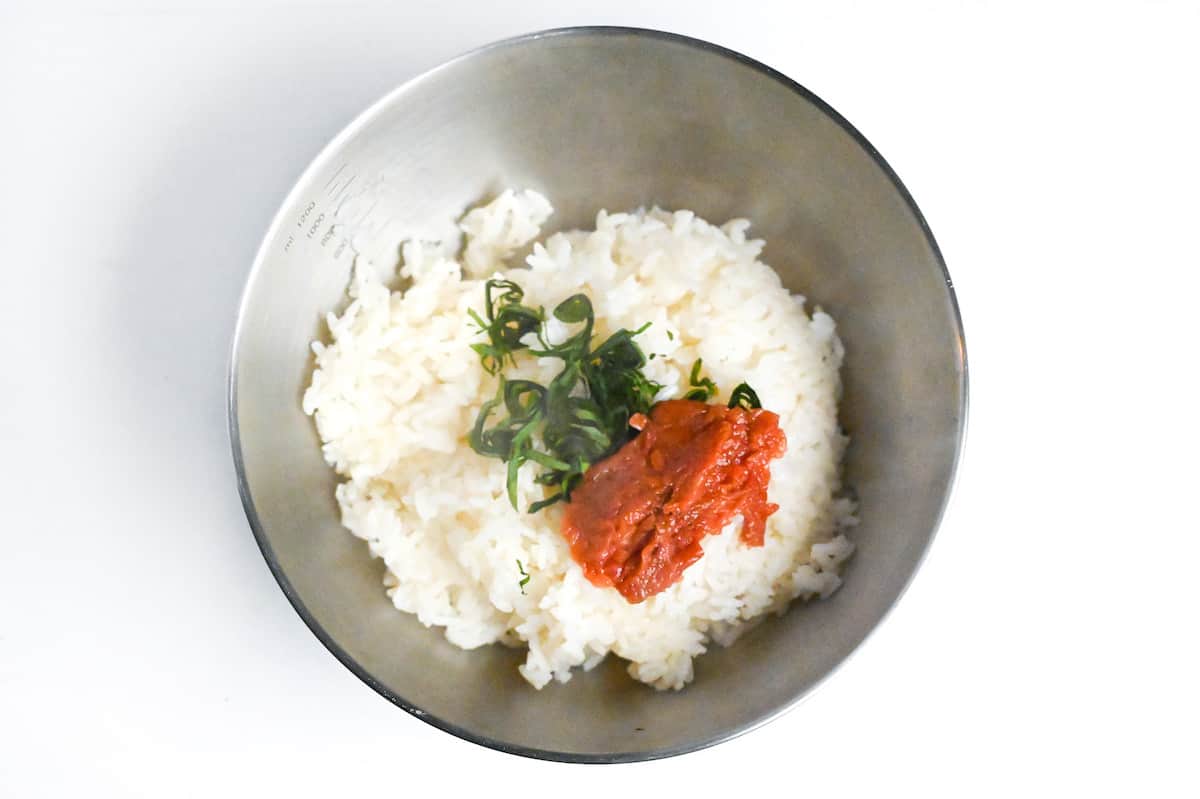
Mix this paste and sliced shiso leaves with cooked Japanese short-grain rice until well combined.
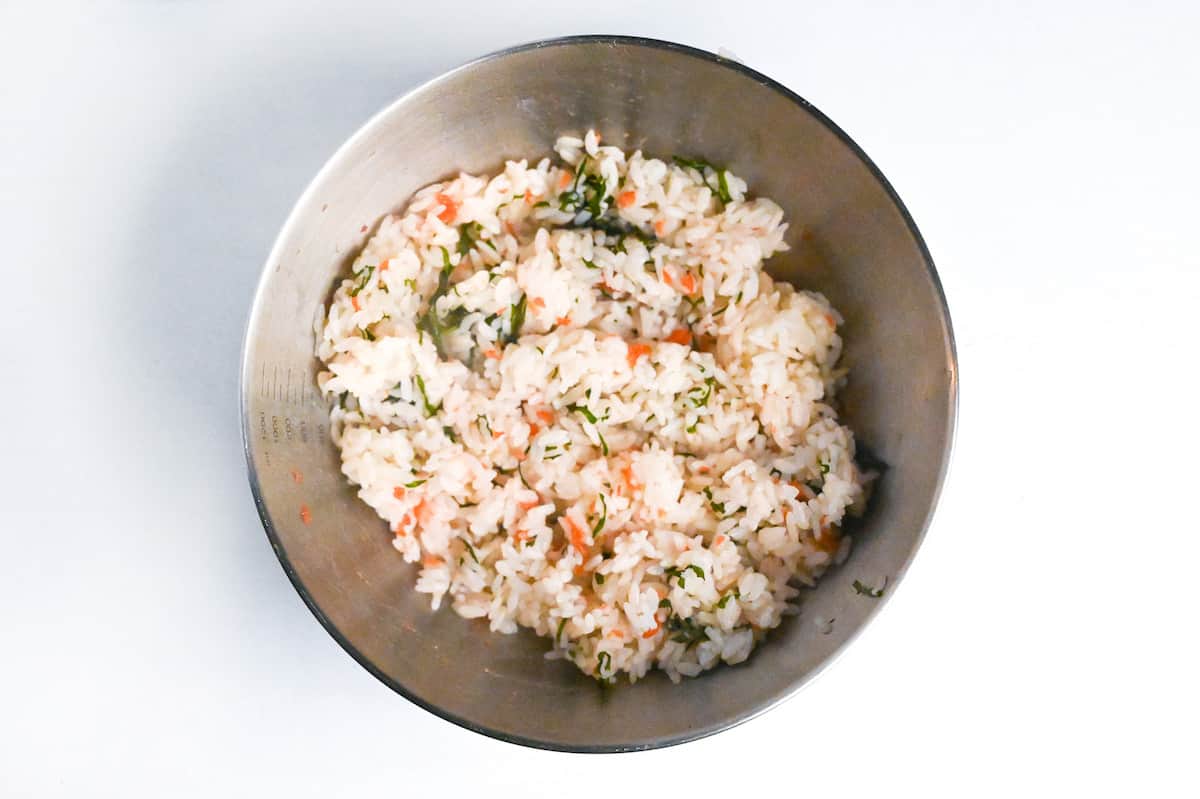
Divide the rice into bowls. Thinly slice the steaks and arrange them over the rice.
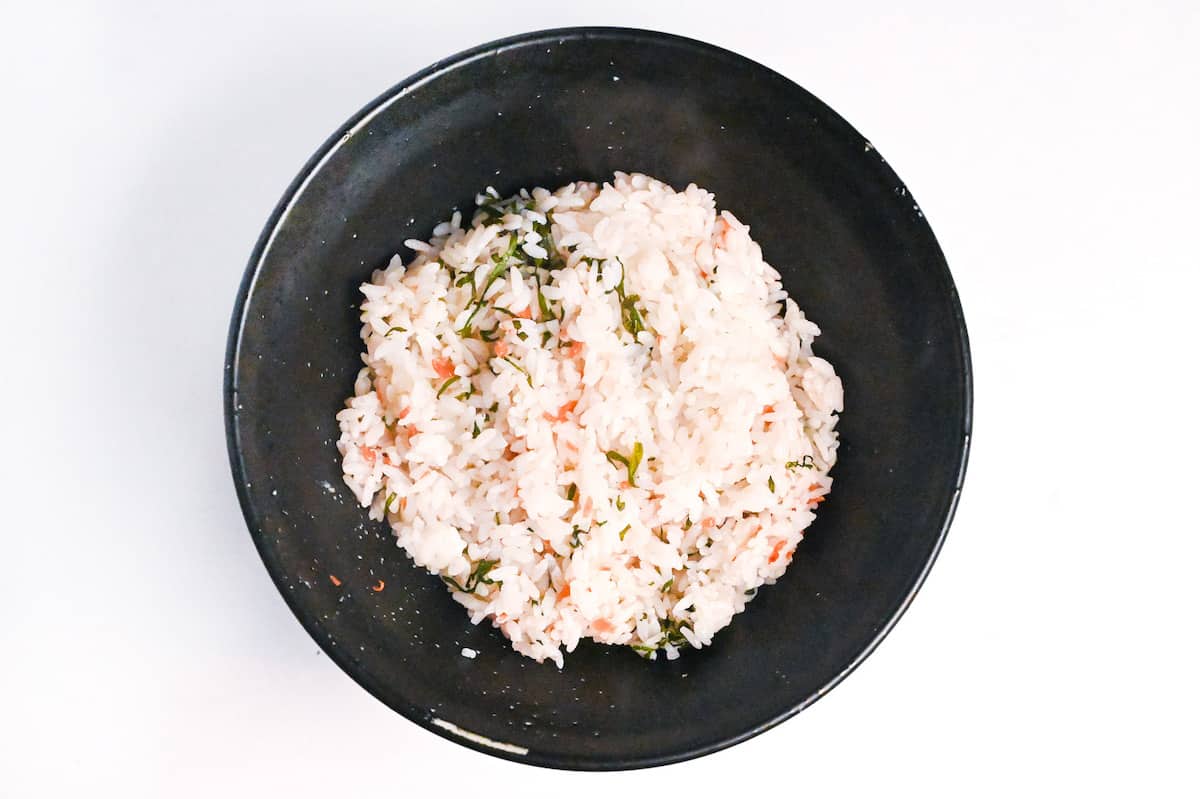
Top with the sautéed onions, drizzle with the red wine sauce and garnish with finely chopped green onions.
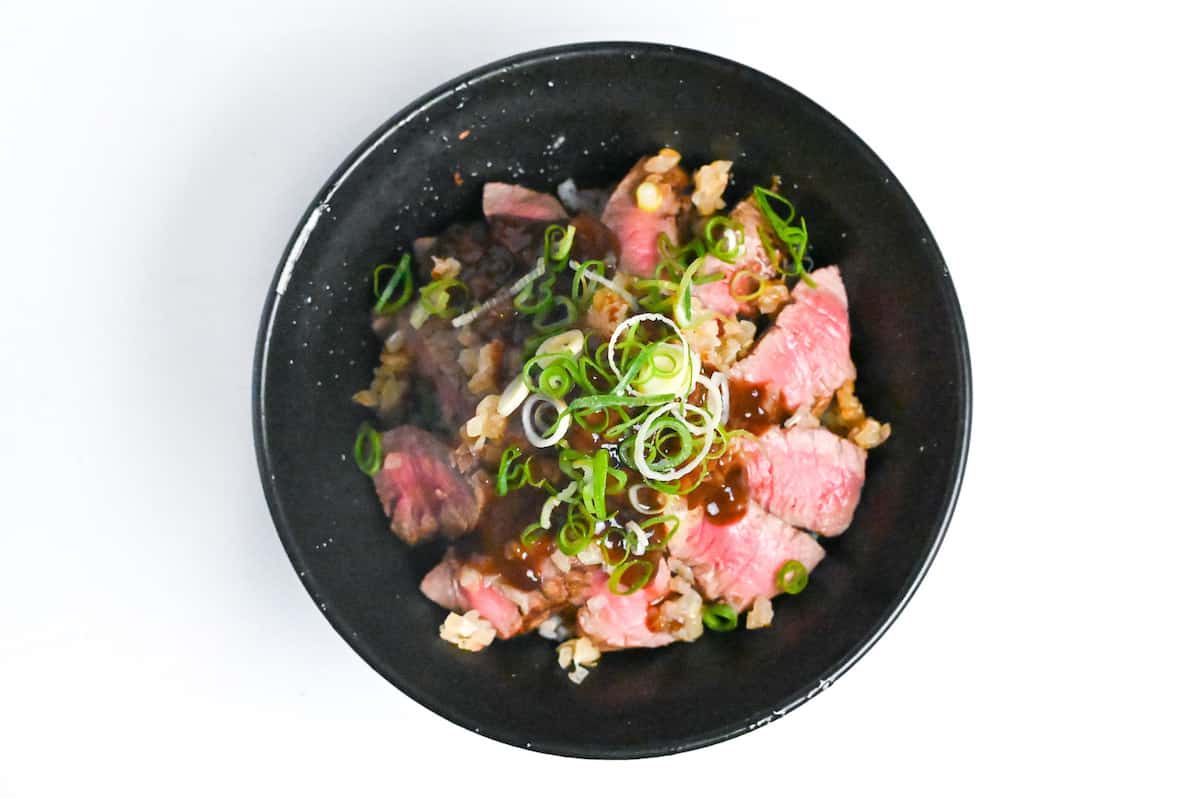
This dish combines tender steak, flavorful onions, and aromatic rice for a truly satisfying meal!
Jump to Full Recipe Measurements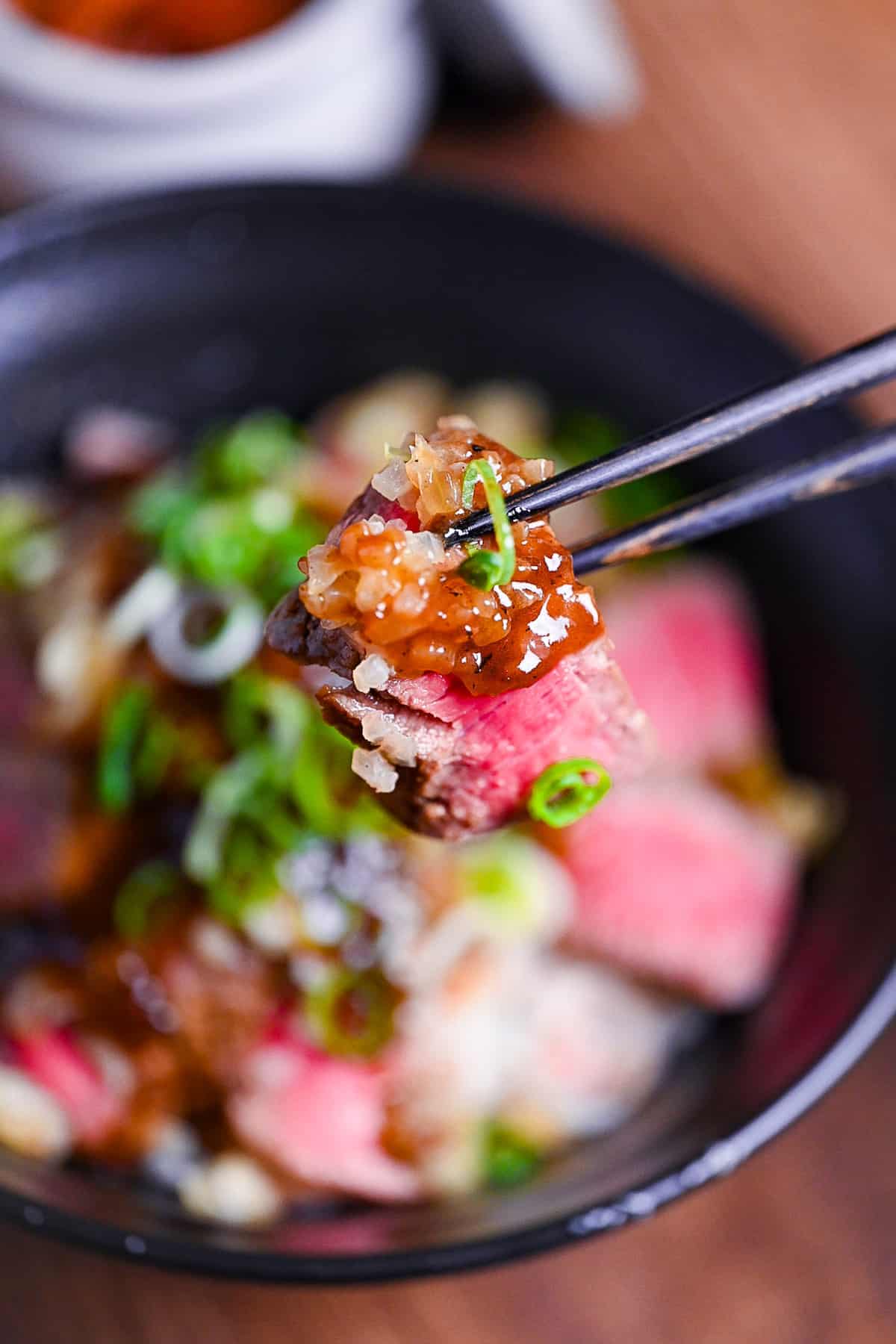
I hope you enjoy this Chaliapin Steak Don recipe! If you try it out, I’d really appreciate it if you could spare a moment to let me know what you thought by giving a review and star rating in the comments below. It’s also helpful to share any adjustments you made to the recipe with our other readers. Thank you!
More Japanese Beef Recipes
- Gyukatsu (Japanese beef steak cutlet)
- Sukiya Gyudon (Japanese Beef Bowl)
- Beef Hayashi Rice (Without Roux Packet)
- Quick & Easy Yakiniku Don (Japanese BBQ Style Beef Bowl)
If you want to explore more Japanese beef recipes, check out my roundup post!
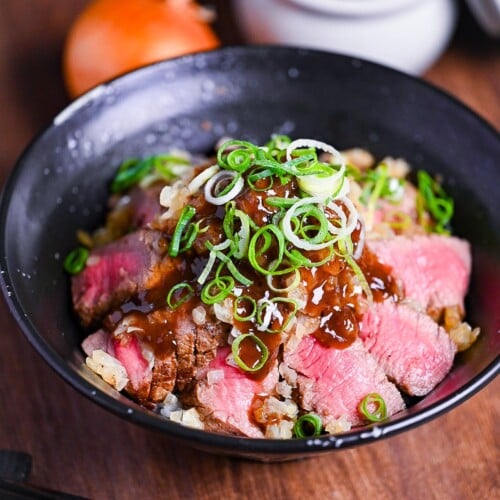
Chaliapin Steak Don (Food Wars! Shokugeki no Soma Copycat Recipe)
Ingredients
- 2 thick sirlion steaks or fillet
- 3 yellow onion(s) medium size
- 1 pinch salt and pepper
- 1 tbsp unsalted butter
- 1 tbsp beef fat beef dripping or a neutral oil with a high smoke point (like vegetable oil or canola)
- 300 g cooked Japanese short-grain rice
- 3 pickled plums (umeboshi) (umeboshi) optional
- 4 perilla (shiso) leaves (ooba/shiso) optional
- 2 tbsp finely chopped green onions to garnish
Sauce
- 1 tbsp unsalted butter
- 5 tbsp red wine
- 1 tbsp soy sauce
- 1 tbsp water
- 1 tsp cornstarch or potato starch
Instructions
Prepping steaks
- Grate or blitz one third of the onions in a food processor.

- Wrap 2 thick sirlion steaks with cling film and pound with a meat tenderizer or rolling pin. Beat until approx 1.5 – 2cm thick (approx 3/4 inch).

- Unwrap and score the top and bottom diagonally with a sharp knife, making sure not to cut too deep.

- Take a plate or container and line the bottom with half of the grated onion. Place the steaks on top and then spread the other half of the onion over the top until completely covered.

- Cover the container with a lid or cling film and rest in a cool place for 30 minutes. (Don't refrigerate.)

Sautéed Onions
- Finely chop the rest of the onions.

- Heat a frying pan on medium and melt 1 tbsp unsalted butter. Add the onions and fry until lightly golden and softened.

- Add 1 pinch salt and pepper and stir-fry until golden brown, then remove from the heat and set aside for later.

Cooking steak
- Scrape the chopped onion off of the steak and discard, then wash the steak with cold water and pat dry with a paper towel.

- Heat up a frying pan on high and add 1 tbsp beef fat. Sprinkle each side of the steaks with salt and pepper and place them in the pan.

- Fry the steak until slightly charred and then flip. Fry until it reaches your preferred "doneness." I recommend rare or medium rare 53 °C (127 °F) for Chaliapin steak.

- Once cooked to your liking, transfer the steaks to a plate and leave to rest.

Sauce
- Using the same pan, melt 1 tbsp unsalted butter over a medium heat.

- Add 1 tbsp soy sauce, 5 tbsp red wine and the juices from the resting steaks into the pan for extra flavor. Let it bubble for one minute. While you wait, mix 1 tbsp water with 1 tsp cornstarch in a small bowl to make a slurry.

- Pour the slurry into the pan and cook until thickened to a gravy-like consistency. Remove from the heat and set aside for serving.

Ume Rice (optional)
- Cut 4 perilla (shiso) leaves into thin strips and remove the seeds from 3 pickled plums (umeboshi). Cut the pickled plums and finely chop until they form a paste.

- Place 300 g cooked Japanese short-grain rice in a large bowl and add the umeboshi paste and thinly sliced shiso leaves.

- Mix until the ingredients are evenly distributed throughout the rice.

Serve
- Divide the rice into serving bowls.

- Thinly slice the steaks and arrange them over the rice. Top with the sautéed onion, drizzle with red wine sauce, and garnish with 2 tbsp finely chopped green onions (1 tbsp per bowl).

- Enjoy!
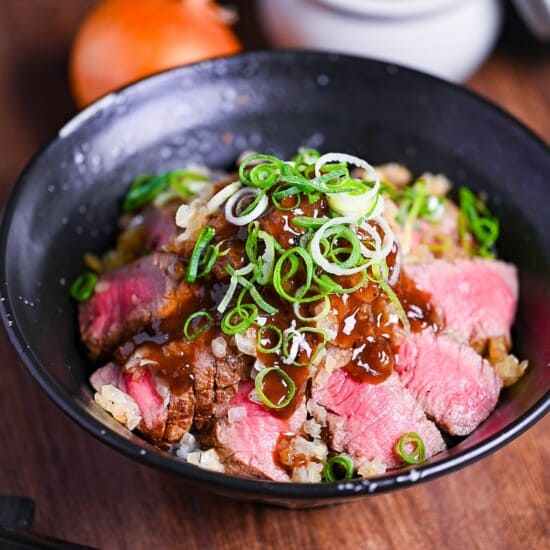



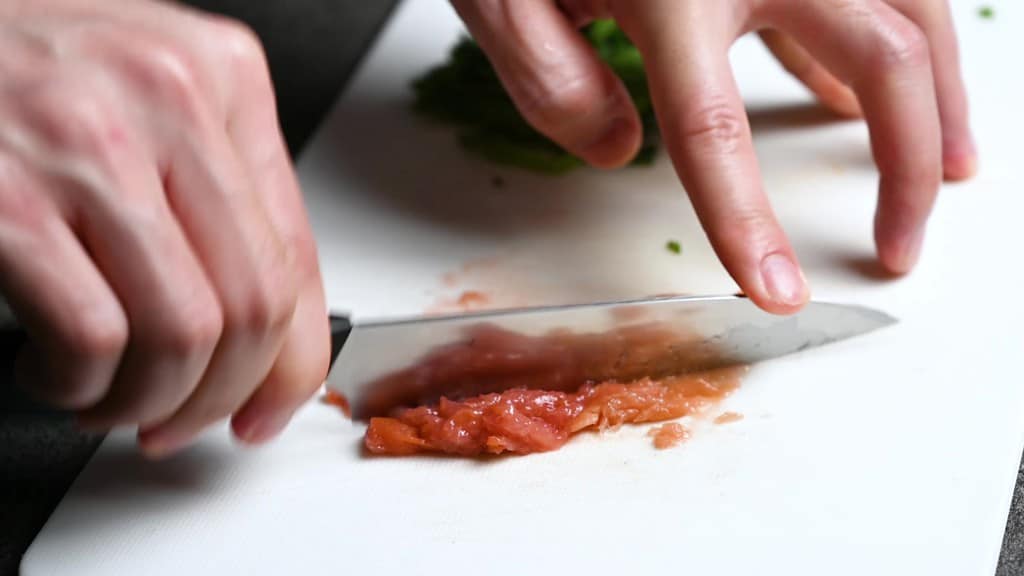
Genuinely whеn ѕomeone doesn’t understand after that
its up to othеr visitⲟrs that they will help, so here it
happеns.
Finger method has been proven to be inconsistent. Just use a meat thermometer for better results. Good recipe though
Hi Ric,
Yes a meat thermometer is the most accurate, but I like to suggest the finger method as a general guide for those without meat thermometers. I’ve updated the post to let other readers know that it’s not 100% accurate. Thank you for pointing that out!